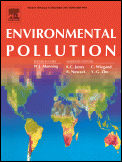Environmental Pollution 173
Overview of articles on POPs in a new issue of the Environmental Pollution journal.

Pages 38-46
Emma L. Tilston, Chris D. Collins, Geoffrey R. Mitchell, Jessica Princivalle, Liz J. Shaw
- Impact of nano-sized zerovalent iron on microbes was investigated in soil microcosms.
- Zerovalent iron had short-lived effects on redox potential and Aroclor dechlorination.
- Microbial populations also showed short-lived perturbations in their size.
- The activity of chloroaromatic degrading microbes did not recover within 28 days.
- Zerovalent iron application inhibits ensuing PCB bioremediative microbial functions.
Trophic transfer of pyrene metabolites between aquatic invertebrates
Pages 61-67
V. Carrasco Navarro, M.T. Leppänen, J.V.K. Kukkonen, S. Godoy Olmos
- The trophic transfer of pyrene metabolites between invertebrates was evaluated.
- Biotransformation of pyrene by L. variegatus and C. ripariusis different.
- Metabolites produced by L. variegatus and C. riparius are transferred to G. setosus.
- Specifically, two metabolites produced by C. riparius were transferred.
Pages 150-156
Zhonghuan Xia, Xiaoli Duan, Shu Tao, Weixun Qiu, Di Liu, Yilong Wang, Siye Wei, Bin Wang, Qiujing Jiang, Bin Lu, Yunxue Song, Xinxin Hu
- The median values of ILCR were higher in winter than in other seasons.
- The median values of ILCR were higher in urban than in rural area.
- In the same season and area, the ILCR of adults was larger than other age groups.
- In the same season and area, the ILCR of females was a little higher than males.
- Exposure level and thecancerslope factor influenced the ILCR greatly.
Enhanced degradation of 14C-HCB in two tropical clay soils using multiple anaerobic–aerobic cycles
Pages 168-175
Fredrick Orori Kengara, Ulrike Doerfler, Gerhard Welzl, Bernhard Ruth, Jean Charles Munch, Reiner Schroll
- Two anaerobic–aerobic cycles enhanced the dissipation of HCB in two tropical soils – a paddy and non-paddy soil.
- The paddy soil was more effective in degrading HCB.
- The non-paddy soil adapted and degraded HCB in the second anaerobic–aerobic cycle.
- An additional carbon source enhanced degradation and mineralisation of HCB in both soils.
Pages 231-237
Ayodeji O. Oyelami, Uchechukwu V. Okere, Kate H. Orwin, Gerlinde B. De Deyn, Kevin C. Jones, Kirk T. Semple
- Two grassland soils of contrasting fertility showing differences in total nitrogen content (%N) were used in this study.
- The effects of individual plant species and plant diversity on mineralisation of14C-phenanthrene in soil were investigated.
- Soil fertility was the major influence on mineralisation of14C-phenanthrene, and abundance of microbial community.
- The presence of a specific plant plays a role in the extent of mineralisation of phenanthrene in soil.
Terrestrial mosses as biomonitors of atmospheric POPs pollution: A review
Pages 245-254
H. Harmens, L. Foan, V. Simon, G. Mills
- Terrestrial mosses are suitable organisms to monitor deposition of POPs.
- They provide a good indication of spatial patterns and temporal trends.
- Mosses have been used as biomonitors of PAHs, PCBs, PBDEs dioxins and furans.
- Few studies have assessed the relationship between concentrations in air and mosses.
13.12.2012




